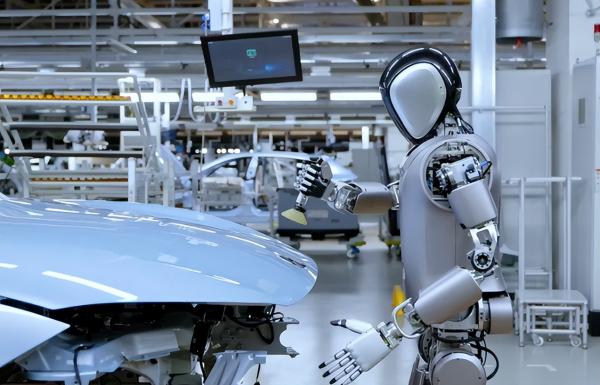Technology and Ecosystem Maturity: Trillion-Dollar Opportunities Emerge as the Robot Industry Awakens
![]() 07/17 2025
07/17 2025
![]() 533
533

From dancing robots to robot marathons and soccer matches, the functionality of robots today is increasingly diverse. Latest data reveals that China's industrial robot export market share surged to second place globally last year, with exports continuing to grow by 61.5% in the first half of this year.
According to Qichacha data, as of July 14, there are currently 363,500 domestic industrial robot-related enterprises, primarily concentrated in East China, accounting for 45.68%. From a national standard industry perspective, over 30% of these enterprises belong to scientific research and technical services. In terms of registrations, the first half of this year saw 47,200 new registrations, marking a 38.52% year-on-year increase. Coincidentally, Wang Xingxing, founder of Unitree Robotics, noted a significant increase in the company's robot shipments this year compared to last.
Echoing the surge in China's industrial robot export market, domestic robot enterprises are also experiencing a period of capital dividends. Just last week, Geek+, the largest robotics enterprise H-share IPO to date, listed on the Hong Kong Stock Exchange's main board, becoming the largest non-"A+H" technology enterprise IPO in Hong Kong this year. Simultaneously, enterprises such as CloudMinds Technology, Estun Automation, Shenzhen Zhaowei Machinery & Electric, Sanhua Intelligent Controls, Roborock, Woan Robotics, Ludong Robotics, Standard Robotics, and Shanghai XianGong Intelligent Technology have all submitted prospectuses.
China's industrial robot market is currently experiencing a scene of synchronous resonance. On one hand, industrial robot enterprises are developing more robots tailored to various scenarios, driving an increase in shipments. On the other hand, the capital market is continuously infusing strength into these enterprises, fostering their rapid development. Clearly, industrial robots are emerging as a new growth engine.
Technology Gradually Matures and Advances
Behind the surge in robot shipments lies the gradual maturity and improvement of robot-related technologies. According to the Beijing Business Daily's report "Evolution of Humanoid Robots," technological breakthroughs are redefining the boundaries of robot movements, with more visible and sensible movements and behaviors allowing humanoid robots to consistently push boundaries. This includes software and hardware collaborative optimization, fault self-healing mechanisms, and long-cycle reliability. For instance, the fault self-healing mechanism enables robots to switch to a backup control mode in case of joint overheating or sensor failure, ensuring task continuity—crucial for practical applications. Industry-level thresholds, such as deep supply chain integration, patent layout density, and standardized discourse power, determine whether technology can transition from the laboratory to large-scale commercial use.
With technology's gradual maturity and improvement, the "Tiangong" from Beijing Humanoid Robot Innovation Center Co., Ltd. won the championship in the world's first humanoid robot half marathon with a time of 2 hours, 40 minutes, and 42 seconds at the Beijing Yizhuang Robot Marathon. The second and third place winners, "Xiaowantong" and "Xuanfengxiaozi," utilized the robot Songyan Power N2, renowned for its optimal and smoothest running posture.
Behind these technological breakthroughs is the integration of AI technology into multiple scenarios and the results of extensive training. With the rise of domestic large models exemplified by DeepSeek, robots are evolving from traditional "execution" roles to today's "decision-making" capabilities. For example, in 2025, robots equipped with the DeepSeek large model already perform dynamic tasks such as serving tea and water and sorting express packages. The open-source technology and cost advantages have attracted over 200 domestic manufacturers, fostering a full-chain intelligent system encompassing "perception - decision-making - execution".
As robot technology matures and improves, it will propel further development in the robot industry. In a sense, the current popularity of the robot market signifies the gradual enhancement of underlying technology and a true reflection of the increasingly robust robot-related infrastructure.
Industry Chain Gradually Forms an Ecosystem
The explosive growth of the robot industry is underpinned by the gradual maturity and improvement of the entire industry chain. The current robot industry is evolving into a comprehensive ecosystem, enabling significant strides in development.
Currently, the Yangtze River Delta and Pearl River Delta have formed industrial clusters with over 3,000 enterprises. Hangzhou, for instance, has gathered enterprises like CloudMinds and BrainCo, specializing in quadruped robots and dexterous hands. In Shenzhen's Nanshan District, over 200 enterprises cover reducers, sensors, and complete machine manufacturing, with local supply chain collaboration shortening the new product development cycle by 30%. In Morgan Stanley's Global Top 100 Humanoid Robots List, Chinese enterprises account for 35%, with seven from Shenzhen selected. The "full-chain" innovation, from core components to end products, allows China to occupy a 63% share of the "body" segment in the global industrial division of labor. Relevant agency predictions estimate that by 2030, the humanoid robot market will reach a trillion-yuan level.
Whether viewed through the lens of the "software industry chain" represented by large models or the "hardware industry chain" encompassing sensors and AI chips, they are both forming a vast ecosystem. Under this ecosystem, the robot industry is entering a new period of explosive growth through continuous strengthening and supplementation of the chain. For example, Ningbo Top Industrial Co., Ltd. recently announced its plan to transfer auto parts manufacturing expertise to the field of humanoid robots, aiming for an annual production capacity of 1 million units and investing 5 billion yuan to establish a core component base for humanoid robots. Another example is Shenzhen Amphenol Technology Co., Ltd., which has entered the robot core supply chain with its six-axis force sensor technology and collaborated with companies such as Midea, BYD, and Huawei. Meanwhile, Shenzhen Zhaowei Machinery & Electric Co., Ltd., a leading enterprise in the domestic micro drive system industry, has made significant breakthroughs in "dexterous hand" technology. Reportedly, the "dexterous hand" features 17 degrees of freedom, a precision error of less than 0.3 degrees, and a lifespan exceeding 10 years.
As this comprehensive industry chain ecosystem gradually forms, the production and supply of robots will no longer be a challenge. With the continued maturity and improvement of the robot industry, especially the formation of industrial cluster effects, the robot industry may usher in a period of sustained and stable growth.
Scenarios Gradually Enrich
As mentioned earlier, today's robots not only dance but also participate in marathons and soccer matches. In fact, this is just a glimpse of their capabilities. Robots have already infiltrated various scenarios, including cooking, cleaning, logistics and distribution, entertainment, and more. It is no exaggeration to say that robots have become a striking feature in many application scenarios.
Regarding the current application scenarios of robots, their integration into traditional scenarios is crucial. Taking traditional automobile manufacturing as an example, the incorporation of robots has become a new starting point for intelligent upgradation. Currently, UBTECH has collaborated with Audi FAW, BYD, BAIC BJEV, and other enterprises, becoming the only humanoid robot enterprise worldwide to announce cooperation with multiple automobile companies. UBTECH's Walker S series has become the industrial humanoid robot that has entered the most automobile factory training sessions globally, receiving over 500 intent orders from multiple electric vehicle manufacturers.
Simultaneously, Xiaomi's automobile factory has introduced over 700 robots to directly serve the production line, achieving 100% automation of key production processes. Beijing Benz's second body factory boasts 625 industrial robots, with a 100% connection automation rate and assembly automation rate, maintaining an industry-leading position.
Beyond automobile manufacturing, robot applications have also expanded into the medical field. At the GE Healthcare Beijing production base, the robot in the surgical machine product's automatic test tunnel performs test calibration, position correction, and radiation dose measurement based on the automatic test system, addressing issues like radiation safety and long test times. It realizes intelligent image analysis and processing, quality judgment, making the efficiency of this 20-person production line equivalent to that of a 200-300-person factory, increasing labor productivity by 44% and shortening the production cycle.
Furthermore, in the field of medical rehabilitation, robots are also present. Earlier this year, Fourier Intelligence launched the first domestic embodied intelligent rehabilitation demonstration base in Pudong, Shanghai. Since its establishment in 2015, Fourier Intelligence has focused on rehabilitation robots, particularly lightweight rehabilitation exoskeletons, enabling Paralympic champion Yao Fang to stand up again. Starting from 2020, Fourier Intelligence invested in actuator research and development. In 2021, various ontology robot forms emerged. In 2022, the first humanoid robot prototype was born. In 2023, Fourier Intelligence officially released the general-purpose humanoid robot GR-1, featuring an adult-like appearance and structure design and smooth human-computer interaction capabilities. In 2024, the second-generation product GR-2 was launched. In 2025, Fourier Intelligence successively launched open-source datasets and open-source robot products FourierN1, marking the company's rapid iteration and open determination in the field of humanoid robots.
As robots begin to land and be applied in more scenarios, market demand will inevitably increase, fostering a new round of growth for robot enterprises and bringing more imagination to the robot market.
Concluding Remarks
With the gradual maturity of robot technology and the formation of the industry chain ecosystem, the robot industry is entering a period of explosive growth. Perhaps this is just the beginning. In the future, as robots increasingly appear in various scenarios, especially with the breaking down of barriers between robots and industry applications, they will become a new infrastructure. With robots at the core, traditional industries will undergo a wave of intelligent upgrades, and people's lives will experience transformative changes.







